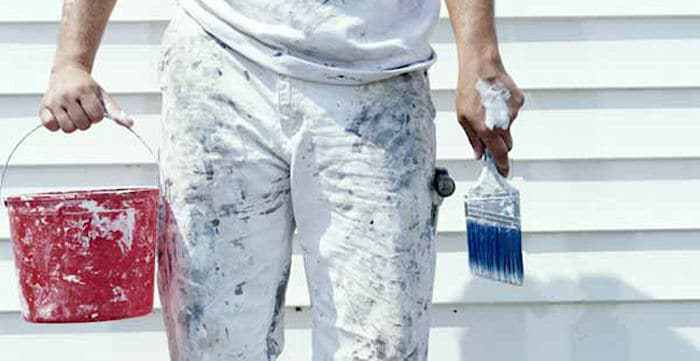(and When It’s Time to Call a Professional)…
If you’re anything like us at Handyman Assist, you probably waited with bated breath to find out what Pantone’s 2017 Colour of the Year is (spoiler alert: It’s called greenery!) and were instantly inspired to switch up your wall colours so you could use that gorgeous, springtime shade of green.
It’s tempting to head over to your local hardware or paint store and dive right into the painting process. Just a few paint buckets, brushes, tarps and tape, and you’re ready to go, right?
But here’s the reality: Painting the interior of your home is an endeavour that requires a great deal of time and some skill, too. It’s one of the most underestimated home projects that you could ever undertake.
So here’s the expertise of our seasoned, professional painter on the process of painting a home, from prep to cleanup, and when it might be time to call in the experts.
BEFORE YOU BEGIN
We have a few insights on taking on a painting project.
We have spoken to a lot of homeowners that absolutely despise painting and we always ask them why, and the number one reason is patience.
The need for patience starts with the preparation process and continues all the way through to cleanup. What could take a professional a few hours, might take a homeowner all day. In fact, it tends to take homeowners twice as much time to paint as it would take professionals. This is because most homeowners lack experience and so don’t always know the right techniques.
While you might want to take on this feat in hopes of saving money (versus paying for a professional), consider the concept that time IS money. When you hire a professional, you’re paying for their well practised time and also for their expertise in the craft.
In the paint industry, you get what you pay for.
But if you’re still determined to take a shot at painting your home’s walls yourself, keep the following tips in mind.
PREP TIME
If you’re seeking advice on the process of “prepping” you’ll find that that word can mean lots of different things to various professional painters. However, a few aspects remain consistent across the industry. From moving and covering your furniture to caulking the cracks in your ceiling, prepping is the process of preparing the interior of your home for a new coat of paint.
STEP 1: MOVING FURNITURE
Before you begin applying paint to your walls, take the time to move (or remove, if possible) all the furniture and other items in the room you’ll be painting. This includes any wall hangings, such as picture frames, mirrors, etc. It may be easiest to gather the furniture in the middle of the room, away from the walls, rather than moving it all out. After that, simply cover your furniture completely with plastic, wrapping it tightly with tape to keep the paint from dripping on it.
Note that some of your furniture may be too heavy to lift on your own, so you may need some additional muscle to move everything.
One thing to consider: Most professional painters include moving furniture as part of their services. If you’re unable to move heavy furniture yourself, now might be time to call in your professional.
STEP 2: PROTECTIVE WEAR
Just as you made efforts to protect your furnishings, take time to protect yourself too.
Handyman Assist suggests using goggles for proper eye protection. In addition, wear clothes you won’t mind ruining, just in case you drip paint on yourself.
If you’re planning on sanding, consider using a facemask to protect your lungs from inhaling dust and debris.
STEP 3: CLEAN AND REPAIR THE WALLS
In cases of extremely dirty surfaces, Handyman Assist also recommends a good wall cleaning before a coat of paint.
Take time to wipe and clean your walls before painting. For bathrooms and kitchens (surfaces that tend to build up grease and dirt), use Sugar Soap or three teaspoons of laundry detergent to a gallon of water. Apply to the walls with an old towel or rag.
STEP 4: SEARCH FOR AND FIX FLAWS
We also suggest taking the time to search for any flaws in your walls, such as nail holes, dents and cracks. Depending on the size of the room, this step might take longer than you expect.
Sometimes, we even use a halogen light and move it up and down the walls to help us catch the slightest flaw. That’s something that homeowners might not think of. They might not want to take the time to patch unless it’s a nail hole from a picture, but there’s a lot more to it. Even the slightest shadow or the sun shining right up against a wall is going to reveal any flaw.
We further suggest removing any cracked or flaking paint leftovers. A regular paint scraper, sandpaper or an electric sander are typically used for minor flaws like plastering bumps.
Just like moving furniture, most professional painting companies offer this service. By taking the time to fix every flaw in your wall, you’ll ensure that your paint job has the overall quality and durability that you’re looking for.
STEP 5: TAPING AND TARPS
You knew it was coming: the dreaded painter’s masking tape. This step will most likely take the bulk of your prep time.
If you want straight lines on your ceiling, walls and trim, you should tape everything out, it takes a little time, but you get far better results.
Be sure to protect any lighting sconces, window frames or lighting fixtures before you paint. This can be done with painter’s tape or tin foil. Tin foil is advantageous with harder-to-cover surfaces in your home, like lighting sconces and door handles. Wrap it around the entire surface and mould its shape to the object it’s covering.
Since you never know where your paint might go, lay down a tarp or dust sheets to keep your carpet and flooring paint-free.
Most professional and seasoned painters don’t need to tape up before they paint, they are well practised at cutting in around stuff, which is one reason they’re so much faster than the average homeowner.
TOOLS FOR THE TASK
Now it’s time to discuss the tools of the trade preferred by the professionals themselves. From high-end to affordable, tools range in price, but the key concept to remember is that you tend to get what you pay for.
To get started, here are some of the most basic supplies you’ll need for prepping:
- Patch blades (6, 8 or 12 inches)
- Patch or caulk
- Sandpaper or an electric sander
- Protective eyewear
- Facemask
After you’ve fixed any holes or flaws in your ceiling, walls and trim, these are the items you’ll need to start painting:
- Can opener
- Paint cans
- Stirrers
- Roller covers
- Brushes (in a range of sizes)
- Trays
- Rags or old towels
- Extension pole
- Masking or Painter’s tape
- Paint spout
When buying brushes, you get what you pay for but having said that, we recommend a mid priced brush for most purposes. Leave the expensive kit to the pro’s who will get the wear from them they are designed for. A mid priced brush is a good work horse solution where only rarely will you meet with the odd loose bristle. There are also brushes that you can throw away after one use. We suggest this route specifically for homeowners because they’re decent-quality brushes that can be purchased at any paint or hardware store for a reasonable price and then easily disposed of after your project.
PROFESSIONALS’ PREFERRED PAINT BRANDS
With hundreds of different paint brands on the market, how do you know which is the right one for you? Price and quality vary, so it’s good to do your research. In the paint industry, you get what you pay for. If you want to buy something cheap that will last a couple years, then you’ll get away with a lower line. But you definitely get what you pay for.
HOW MUCH PAINT YOU’LL NEED
Next, figure out how much paint you’ll need for your project. Measure the square footage of the room you’re planning to paint. 5 litres of paint typically covers 450 square feet of area.
When it comes to choosing a suitable colour for your room, test the colours on the walls before you paint the entire wall.
Don’t trust impressions and make decisions based on in-store colour swatches. There are many factors that affect your final result. Make sure you take interior lighting into full consideration. Testing your paint is mandatory. Swatches never reflect the actual colour of a finished paint job.
TO PRIME OR NOT TO PRIME?
A lot of people like to prime the entire room but we never thought it was necessary, especially with paint now-a-days in which you find primer in it already. However, if you’re going to do a lighter paint colour over a darker existing paint colour, it’ll show through, even after two coats. That’s when you might want to prime.
Make sure you choose the right primer. A water-based primer is typically used for drywall, while oil-based primers would be applied to stain-covered walls or panel installations. You may even want to tint your primer to the colour you plan on using on the walls, so you can prime and lay your first coat at the same time. You can have a professional tint your primer at any paint or hardware store.
PAINTING ORDER
Start at the highest point of the room, which is your ceiling, then the walls and working your way down to the trim.
The directions on paint cans usually recommend waiting four to six hours between coats of paint.
You can speed up the process by “forced drying,” which means having a fan blow on the painted walls to help dry them faster. Depending on the amount of “forced air” you have blowing on the wall, you could possibly do a second coat after just two hours.
A WORD ABOUT TRIM
Trim can be identified as base mouldings (or skirtings), window mouldings (or architraves) and crown mouldings (cornices or covings) typically found in the form of wood, plastic or stone. If those elements are present and have been painted before, it might need to be freshened up.
When painting trim: Take the time to look at every crack and caulk it. If there’s any type of hole or nick, I fill that in with filler and sand it down. I use a wet sanding technique to keep the dust from falling down all over the place and a lot of homeowners tend to like that. Next a good undercoat makes it all solid and then two coats of enamel paint over top of it is always the best look.
TECHNIQUE (TIPS AND TRICKS)
You might have heard of the “W” or “V” technique to roll paint on a wall. Start from the corner of the wall and roll on a three foot by three foot ‘W’. Then, fill it in without lifting the roller. Repeat until you fill the entire wall in. This technique is used to help hide seams and spots where the roller contact was lost or placed again.
When dipping your brush in the paint, tap it flatly against the side of the tin. You don’t want to scrape it against the can’s opening because the paint will seep into the seal, making it harder to close up. This also leaves excess paint back into the can, limiting your waste of paint.
THE CLEAN-UP PROCESS
There are a few different things to consider when cleaning up after painting.
First, don’t clean oil paints in a sink. You have to use thinner to clean up your gear and brushes. This will require you to clean your gear in a separate receptacle, like a disposable tub or plastic bucket, filled with any cleaning agents, like soap and water or laundry detergent.
The thinner can’t be disposed curb-side. Find out how your city handles disposal of paint thinners and where you can turn in the bucket of thinner to be disposed of properly by a professional.
You can dispose of paint via curb-side trash pickup, but you have to add a drying agent to the paint before putting it out. Drying agents include cat litter and sand to soak up any remaining paint. The paint lids must also be removed.
However, if you’d rather keep your extra supplies and paint, we suggest washing the brushes in a softener mix. By mixing two tablespoons of fabric softener and warm water, you can create an overnight soak that will lift dried on paint to be scrubbed off the next day.
Additionally, you might not want to throw out your left-over paint, always set aside paint reserves in case of unexpected stains in the near or distant future. Different batches might come with different results in terms of colour.
If you find yourself with a few extra cans of paint after your DIY project, we have a few suggestions on what you can do with your leftover paint (coming soon).
For more information on painting, click here
© Andy Robinson, Localad Services Handyman Assist
If you have enjoyed reading this article… Be sure to check out my many other Posts. Or better still, for up to the minute notifications of what I am up to, why not subscribe here for free?







Recent Comments